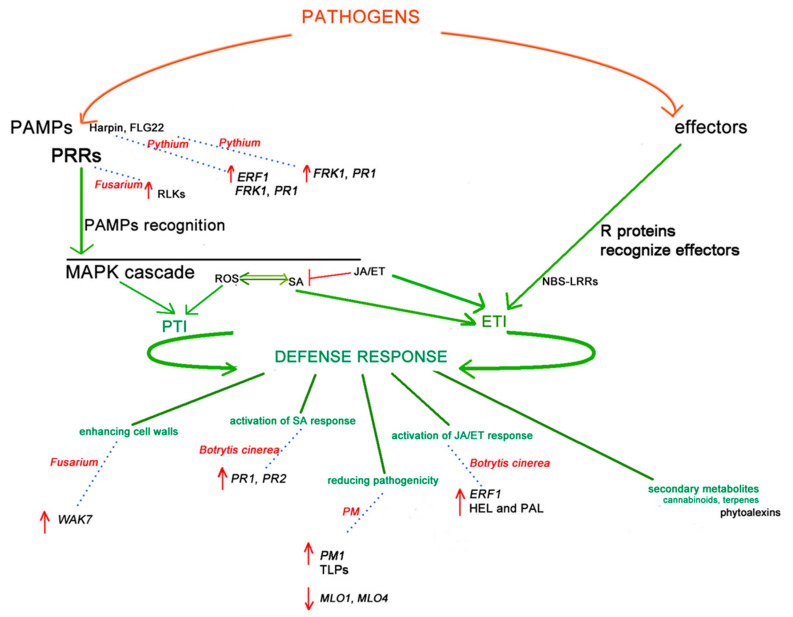Figure 1.
A model of Cannabis immune and defence responses to PM, Fusarium spp., Botrytis cinerea and Pythium interactions. The initial defence response, shared among plants, starts with two types of molecules which are derived from pathogens. Pathogen-associated molecular patterns (PAMPs), recognised by the plant pattern recognition receptors (PRRs), activate the PAMP-triggered immunity (PTI) and initiate the first plant defence response, giving a basic level of resistance to most non-specialised pathogens. Two PAMPs, Harpin and Flg22, are involved in the Pythium defence response, both induce FRK1 and PR1 and only Harpin induces ERF1. While PRRs, receptor-like kinases (RLKs), are involved in the Fusarium defence response. Reactive oxygen species (ROS) production and mitogen-activated protein kinase (MAPK) also induce PTI. Effector proteins are the other type of initiators. Effector-triggered immunity (ETI) induced by the interactions of R proteins (e.g., nucleotide binding site-leucine-rich repeat (NBS-LRR) proteins) and pathogen effectors can start the second line of host-induced defence responses. The salicylic acid (SA) and jasmonic acid (JA)/ethylene (ET) signalling pathways are involved in PTI and ETI activation and the resistance response to pathogen infections, stimulating downstream transcription factors and plant defence responses (e.g., enhancing cell walls, the activation of SA response, the reduction of pathogenicity, the activation of JA/ET response and the secondary metabolites involvement). Genes reported to strengthen the plant cell walls, such as the WAK7 gene, are upregulated (red arrow in the model) in Fusarium Cannabis response. Genes involved in SA response, such as PR1, PR2 (Botrytis cinerea response), and JA/ET response, such as ERF1, encoding HEL and PAL (Botrytis cinerea response) are all upregulated during infection. Other genes are reported to reduce virulence, such as the PM1 gene and MLO1 and MLO4 (Powdery Mildew (PM) response), which are upregulated during PM infection. The phytoalexins involved in the biosynthesis of specific terpenes may also be involved in pathogen response. Arrows (in green colour) indicate positive regulation, and open blocks (in red colour) indicate negative regulation. Green lines indicate defence response mechanisms associated with different pathways. Blue pointing lines and the associated red pathogen name indicate genes/gene families involved in the defence response.

